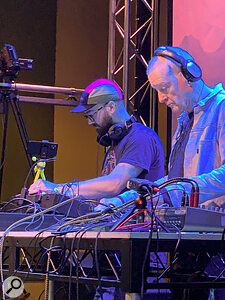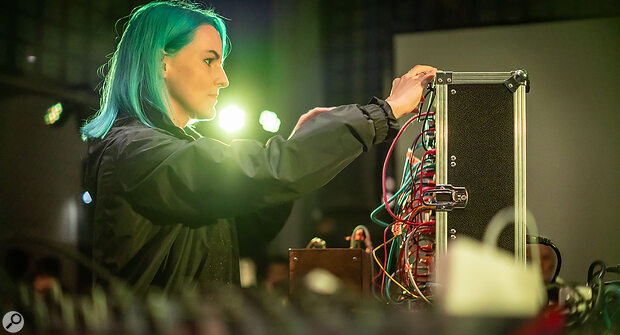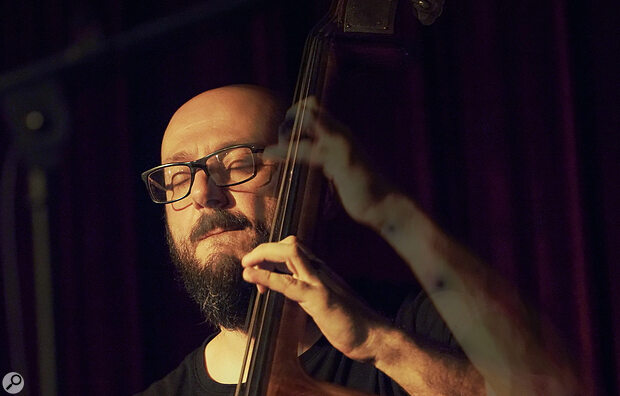Thinking of taking your Eurorack on the road? We offer some expert advice...
As musicians, we suffer from that inescapable desire to project our music out into the world. With the rise in EMOM (Electronic Music Open Mic) gatherings and consistent interest in experimental electronic music, there’s more opportunity than ever to perform live electronically. However, if your chosen vessel of expression is the modular synthesizer, how do you transform your kitchen table experiment in patch cable origami into something performable?
In order to bring a broader range of usefulness to the table, I reached out to a number of modular artists and musicians (see the ‘Modular Contributors’ box for the full run down) to get some wider insight into how to approach the challenges of performing with modular.
Performing with modular has some unique challenges, but they are offset by how engaging the whole process is.
Portability
Modular synthesis is somewhat unique in its versatility and complexity. When you grab a guitar and head out to perform as a singer‑songwriter, you only have to decide what songs to sing and perhaps which pedal to take. With modular, you have to start by building your instrument. When playing at home, patches tend to bleed out into multiple cases, odd racks, other bits of gear, effects, mixers and anything else a patch cable can reach. So, your first consideration needs to be around the logistics of successfully getting some modular to the venue. It will probably be unrealistic to take everything, so you might need to consider getting a compact case that will travel well. Intellijel and Befaco both do 7U cases designed for this purpose. Perhaps you need two cases, but how long would you need to set up the patch between them? I’ve used a pair of Arturia RackBrute cases that work together in a clamshell configuration and has a bag designed to hold them. If you use compact patch cables, you can pack it away completely patched. However, it’s cumbersome to carry.
The trick then becomes fitting the sounds you want to make within the confines of the case or cases you can reasonably transport to the gig, and set up at the other end. There doesn’t appear to be an ideal solution to this. I’ve seen Mylar Melodies and Julia Bondar pull off amazing sets with a single case, and I’ve enjoyed Loula Yorke and Panic Girl exploring the possibilities in two cases and more. I find that the building of the instrument and the choice of modules are actually part of the modular experience and as unique to the player as the music they’re making.
 Loula Yorke.Photo: Victoria Wai
Loula Yorke.Photo: Victoria Wai
Sight, Sound & Safety Nets
But what about the business of actually performing? First off, pretty much everyone I’ve spoken to can agree on a couple of universal factors.
- It will sound different. You may not be able to hear the things you thought you would; the monitoring may be mono or so muddy you can’t really distinguish sounds or match them to what you’re doing. On the one hand, this can be exciting, on the other, it can knock your confidence and leave you flailing.
- You won’t be able to see anything. The lighting will probably be terrible, and your modular will be at the wrong height. The darkness, coupled with the brightness of your racks LEDs, will make it impossible to read any labels. The height problem is less easy to solve as the table provided for your performance could be at any height. Having an adjustable desktop stand can be helpful. Gaz takes a Stay Music stand with him so that his rig is always at the right height and in the best position for him to play.
 Gaz Williams.During my first live performance at an EMOM in Norwich, I blundered naïvely into these issues. I was able to push on through, but it made the experience far more stressful than it needed to be. Another lesson I learned on that first outing was to patch loosely. Just before I packed my case into a bag to take to the gig, I decided to replace any dangly long cables with nice, short and tidy ones. The case looked very neat, but when it came to the performance, I struggled to get my fingers between the tight cables to turn the knobs. And as I already couldn’t see or hear anything, it added yet another level of difficulty.
Gaz Williams.During my first live performance at an EMOM in Norwich, I blundered naïvely into these issues. I was able to push on through, but it made the experience far more stressful than it needed to be. Another lesson I learned on that first outing was to patch loosely. Just before I packed my case into a bag to take to the gig, I decided to replace any dangly long cables with nice, short and tidy ones. The case looked very neat, but when it came to the performance, I struggled to get my fingers between the tight cables to turn the knobs. And as I already couldn’t see or hear anything, it added yet another level of difficulty.
Some of the struggles our panel of experts highlighted revolve around logistics, such as having time to set up your patch, warm up your oscillators, and keep them in tune. Other thoughts were around having a big enough rig to cover a long set and being able to transition smoothly from one piece to another. Other struggles were around the nature of the performance itself. Nicola has had difficulty finding the same level of expression that he’s used to with acoustic instruments, whereas Gaz has pushed back against the pressure to be virtuosic, where he suggests that “more notes and ideas do not necessarily make for better music”. Alex threw in the most devastating comment to imply the ridiculous notion that sometimes what is needed is more practice, not more modules!
All sorts of things can happen on the night, from the gig being completely empty to module failure, power cycling and dodgy patch cables. One tip from Martha is that she always takes an iPad as a safety net that she can run a track from while she’s doing an emergency restart. I’ve seen Loula and Steve use modules like the Music Thing Radio Music with spoken word samples or recorded oddities to fill in time while repatching. It’s an excellent way to mask a transition.
Improvisation
I asked the panel how pre‑patched and pre‑programmed they are and how much room there is for improvisation. What’s interesting about that question is that they are not as related as you’d think. Most of the panel arrived pre‑patched and ready to play, and some said they would never change the patch in a performance. And yet they nearly all improvise to one degree or another within that patch. There were a couple of exceptions: Nicola would patch up just before going on and improvise from there. Julia arrives fully patched and works everything from the Endorphin.es Ground Control sequencer, recreating songs and album tracks with little or no intentional improvisation.
Overall, there’s a bias towards having something pre‑prepared as a starting point, at least some known sequences and chosen sound sources, and then improvising from there. Martha had an interesting approach that brought in some additional instruments to improvise around a more defined modular case: “I need a fair amount of pre‑programmed ‘safety’ patches and sounds that will work 100 percent on stage, but I also love to improvise in the moment with certain elements of the tracks. I usually like to use my Cocoquantus for that purpose, along with the OP‑1, a touch controller module combined with the Polygogo, or whatever sound source I feel like using at that moment, as well as the Keystep from Arturia.”
Gaz has also started toying with something a bit more prepared after doing a lot of fully improvised performances. “So far it’s been 100 percent improvised but now with the addition of the Oxi One sequencer I’m starting to pre‑program certain conditions. This will allow for more diverse sets without compromising the improvised nature of it. For instance on the Oxi you can store in a pattern parameters that pertain to random note generation. This feels like a way to still embrace free improv but with a certain amount of control of the results.”
From my perspective, I find I have enough room in my case to create three or four different sound generators. That might be a couple of sequenced oscillator‑to‑filter synth voices, some percussion and perhaps something that can be played as well as effects that can be fiddled with. For a 15‑minute EMOM performance, you can get away with dropping those elements in and out without having to rework anything or improvise too much. However, once you are booked to play for 30 minutes or more you are going to have to either improvise or pack in more sounds, options and variations. On the question of whether to pre‑program or improvise, Alex, who always improvises, suggests, “The crowd has no idea, so why bother? That’s a question. Ultimately, what matters is what comes out of the speakers and whether you are happy with it.”
Practicalities
 Alex Theakston, aka Mylar Melodies, and Steve Davis.With all the challenges that modular faces, wouldn’t it be less stressful to perform with easier gear? There’s certainly a sense that the logistics could be easier, and part of developing your set is finding more efficient pathways to reduce the size of your rig. But no one wants to lose the joy, excitement and possibility that performing with modular brings. Steve summed this up nicely: “Yeah, sometimes I’ve thought that it would be far easier just whacking everything into a sampler and just rolling up with a Black Box and a few effects, but then I realise that most of the magic moments we have had have arisen from the unplanned stuff and then just running with them. I’m not sure I’d be so sure if I was a solo performer, but within the structure of a three‑person band, there is a lot of time to reflect on that old adage that less is more. I’m pretty sure some of our best music has been when I’ve been scratching my head, holding a patch wire, trying to work out where it was supposed to go!”
Alex Theakston, aka Mylar Melodies, and Steve Davis.With all the challenges that modular faces, wouldn’t it be less stressful to perform with easier gear? There’s certainly a sense that the logistics could be easier, and part of developing your set is finding more efficient pathways to reduce the size of your rig. But no one wants to lose the joy, excitement and possibility that performing with modular brings. Steve summed this up nicely: “Yeah, sometimes I’ve thought that it would be far easier just whacking everything into a sampler and just rolling up with a Black Box and a few effects, but then I realise that most of the magic moments we have had have arisen from the unplanned stuff and then just running with them. I’m not sure I’d be so sure if I was a solo performer, but within the structure of a three‑person band, there is a lot of time to reflect on that old adage that less is more. I’m pretty sure some of our best music has been when I’ve been scratching my head, holding a patch wire, trying to work out where it was supposed to go!”
On a more practical note, I asked the panel for the most useful piece of gear to take with them. We got several votes for a tuner, and that headphones are essential. For more specific module recommendations, Gaz relies heavily on the ALM Pam’s Pro Workout as his primary clock source, Nicola keeps a Mutable Instruments Beads and Music Thing Radio Music patched together as an instant single‑knob‑turn safety net, and Steve considers his Korg SQ‑1 a personal friend in a crisis.
What becomes clear is that performing with modular has some unique challenges, but they are offset by how thoroughly engaging the whole process is. Modular is a fascinating way to express yourself, from designing and continuing to massage the contents of the case(s), to the practice and learning of the instrument, through to the sheer excitement and unpredictability of performance.
I am very grateful to the insight of the panel and to summarise their top tips, practice is always good, and so is more practice, although don’t be afraid to mess up and consider the idea that an unstable performance can be an exciting one. Bring more cables than you think you’ll need, don’t forget the lights and mixers can be useful. But above all, have fun.
Modular Contributors
Alex Theakston, aka Mylar Melodies: Modular and synthesizer YouTuber, podcaster, educator and performer.
Julia Bondar: Electronic music artist and co‑founder of Endorphin.es
Gaz Williams: Bass player, music producer, modular improviser and co‑founder of Rack Records that publishes “spontaneous electronic conversations”.
Steve Davis: DJ, modular performer with the Utopia Strong and co‑founder of Rack Records. Used to play a bit of snooker.
Nicola Lancerotti: Double bass player, jazz musician and modular performer.
Martha Bahr, aka Panic Girl: Composer, synthesizer sound designer, nerd.
Loula Yorke: Composer, improviser and performer of modular synths.
The Hardest Thing About Performing With Modular?
Gaz: Feeling the need to constantly innovate and generate significantly different musical ideas that have some cohesion. Keeping certain modules in tune too.
Nicola: Coming from mostly improvised acoustic music, I struggle a lot with expression. It’s harder to translate the dynamics one can achieve with a traditional instrument onto the modular.
Martha: To patch an entire set lasting about 30, 45 or even 60 minutes using just one case. Ideally, the case shouldn’t be too large, as I need to carry it around a lot for live shows. My overall goal is to perform a 45‑60 minute set with a minimal amount of gear on stage.
Loula: At this point, it’s actually the logistics. You will need to check table size and suitability in advance, explain clearly you can’t unplug and move anything, that your oscillators need time to warm up, that you have to have time to set up your patches (but, you know, nicely!). I also suffer mad amounts of anxiety about damaging my gear in transit.
Steve: I struggle with working out how to prepare for the next piece of music without any major hold up in proceedings. Early on, we (the Utopia Strong) did individual pieces, but now we are playing one continuous piece and that makes it even more important to be seamless.
Julia: The hardest part is getting everything to work together as expected. There are so many technical details to learn, which can distract from focusing on the actual music. Luckily, I have the most genius person by my side who helps me set everything up properly — we work as a team.
Alex: Improvising completely and making that entertaining. As well as knowing when what is needed is more practice, not more (or different) modules.
Top Tips
Alex: Practice half an hour a day for two weeks, and remember to go more slowly than you think you should when you’re on stage.
Gaz: To accept that with improvised music there will be natural peaks and troughs and to embrace this. Personally, seeing someone play with a laptop, for instance, and have a perfect‑sounding set is boring, dull and so old‑fashioned now. Having an eclectic and unstable performance makes for a more exciting live experience. I’d strongly urge the performer to angle themselves on stage to allow the audience to see the process as much as possible.
Nicola: Technically, bring always more cables than you need (not just patch cables, but USB, 6.3mm, etc) and have a compressor/limiter out. Before the gig, prepare: play the instrument, the patch, the composition a lot. Then, on the gig, just step back and listen. Time runs differently for you and the audience. I have played gigs where I thought I was boring the audience and felt like stopping to hear them afterwards say, “Why did you stop so early?”. Actually, these are all tips for myself too.
Loula: Get a little clip‑on LED light. Label important patch cables with a tiny bit of tape. Rehearse, rehearse a lot. I do a full run‑through twice a day in the week leading up to a gig, finishing on a rest day where you’re packing down, labelling stuff, making a checklist for loading in and out so you don’t forget anything, and writing a set list with prompts if you need them.
Martha: The most important thing is to rehearse as much as possible, know your gear inside out, and record your rehearsals. Listen to them and analyse what you could improve! Music often feels different when you play live compared to when you listen back to it afterwards; it’s surprising how much it can change. Prepare some safety nets in case something goes wrong, like background tracks that you can play from your iPad. And make a list so you don’t forget anything, like your power supply, tuner, or whatever else you need to make it work. And don’t forget to have fun on stage!
Steve: Get a light; it’s essential! Consider a mixer with the ability to pre‑hear what potential crap you are just about to unleash on an unsuspecting audience. There’s nothing worse than opening up a fader and immediately realising that you need to get rid ASAP!




